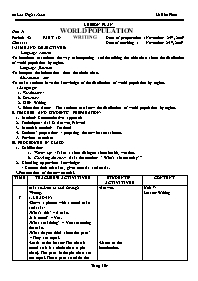Thiết kế bài dạy môn Tiếng Anh 11 - Unit 7: World population - Period: 42 - Part: D writing

I/AIMS AND OBJECTIVES:
+ Language content:
-To introduce to students the way to interpreting and describing the cirle chart about the distribution of world population by region.
+Language function:
-To interpret the information from the circle chart.
+Educational aim:
-To make students have the knowledge of the distribution of world population by region.
1.Language:
a. Vocabulary:
b. Structure:
2. Skill: Writing
3. Education factor: The students can know the distribution of world population by region.
II. TEACHER AND STUDENTS’ PREPARATION:
1. Method: Communicative approach
2. Techniques: Ask & Answer, Pairwork
3. Meterials needed: Textbook
4. Students’ preparation: - preparing the new lesson at home.
5. Previous exercises:
Bạn đang xem tài liệu "Thiết kế bài dạy môn Tiếng Anh 11 - Unit 7: World population - Period: 42 - Part: D writing", để tải tài liệu gốc về máy bạn click vào nút DOWNLOAD ở trên
LESSON PLAN Unit 7: WORLD POPULATION Period: 42 PART : D WRITING Date of preparation : November 24th, 2009 Class: 11 Date of teaching : November 25th, 2009 I/AIMS AND OBJECTIVES: + Language content: -To introduce to students the way to interpreting and describing the cirle chart about the distribution of world population by region. +Language function: -To interpret the information from the circle chart. +Educational aim: -To make students have the knowledge of the distribution of world population by region. 1.Language: a. Vocabulary: b. Structure: 2. Skill: Writing 3. Education factor: The students can know the distribution of world population by region. II. TEACHER AND STUDENTS’ PREPARATION: Method: Communicative approach Techniques: Ask & Answer, Pairwork Meterials needed: Textbook Students’ preparation: - preparing the new lesson at home. Previous exercises: III. PROCEDURE IN CLASS: Stabilization: Warm- up: - Takes a short dialogue about health, weather. Checking absence: Asks the monitor: “ Who’s absent today?” Checking up previous knowledge: - Corrects their mistakes, gives remarks and marks. 3.Presentation of the new material. TIME TEACHER’S ACTIVITIVES STUDENTS’ ACTIVITIVES CONTENT 5’ 10’ 25’ Asks students to look through Writing. 1. LEAD-IN: -Shows a picture with a round cake and asks: .What’s this? – A cake. .Is it round? – Yes. .What am I doing? – You are cutting the cake. .What do you think about the parts? – They are equal. -Leads to the lesson: The chart is round so it is a circle chart (a pie chart). The parts in the pie chart are not equal. These parts stand for the distribution of population in the world, and it is not equal among regions. 2. BEFORE YOU WRITE: -Asks students to look at the circle chart in the textbook and give comments. -Then asks students to use phrases in useful language to compare the population in these areas. -Calls some students to presents their answers. -Gives remarks. -Suggested answers: .The world population is distributed unevenly. .The South Asia ranks first with 32%. .The Oceana has the least population. .Less than that in South Asia is East Asia with only 26%. -Presents the format: +Introduction: A thesis statement. +Body: An interpretation of the data on the chart. +Conclusion: 3. WHITE YOU WRITE: -Asks students to work in groups: Study the chart carefully then write a paragraph of 100 – 120 words, describing the information in the chart. Begin with: The chart shows the distribution of world population by region -Asks some students to present their writings on the board. -Corrects their mistakes. *Model: The chart shows the distribution of world population by region. As seen from the chart, the world population is not distributed evenly. South Asia has the largest population with 32% while the Oceana is the least populated with only 2%. A bit higher than that of the Oceana are the rates of Latin Amreica and Northern America with 8% and 6% -Answer. -Listen to the introduction. -Take notes. -Practise. -Present their answers. -Listen. -Take notes. -Work in group to write the passage. -Present their writings. Unit 7: Lesson: Writing *New words: .it can be seen that .distributed unevenly .account for percent .more than double the population of .half as much as / nearly half of .rank first / last *The format: +Introduction: A thesis statement. +Body: An interpretation of the data on the chart. +Conclusion: * Study the chart carefully then write a paragraph of 100 – 120 words, describing the information in the chart. Begin with: The chart shows the distribution of world population by region *Model: The chart shows the distribution of world population by region. As seen from the chart, the world population is not distributed evenly. South Asia has the largest population with 32% while the Oceana is the least populated with respectively. Europe accounts for 15% of the world population and Africa is a bit lower with only 11%. To sum up, more people are found in Asia than in other parts of the world. only 2%. A bit higher than that of the Oceana are the rates of Latin Amreica and Northern America with 8% and 6% respectively. Europe accounts for 15% of the world population and Africa is a bit lower with only 11%. To sum up, more people are found in Asia than in other parts of the world. 4’ 4. AFTER YOU WRIYE: -Presents some common mistakes and corrects. - Asks sts to summarize the contend of the passage. - Listen and correct - Listen and summarize 1’ 5. CONSOLIDATION: -Reminds the way and language used to describe the cicle chart. -Listen. 3’ 6 .Homework -Asks students to practise speaking the distribution of population by region in Vietnam. - Preparation for the next lesson - Asks students to prepare Language Focus. - Listen and do the teacher’s requests V/ Self – evaluation: ......................................................................................................................................................... ........................................................................................................................................................ ........................................................................................................................................................ ........................................................................................................................................................ ........................................................................................................................................................
Tài liệu đính kèm:
 TIẾT 4.doc
TIẾT 4.doc





